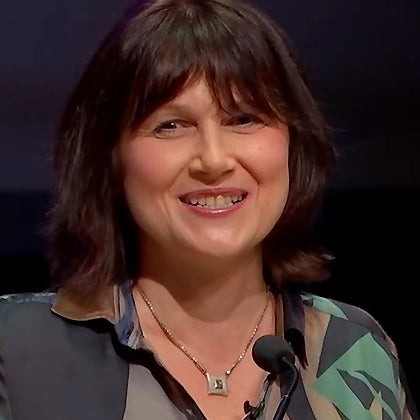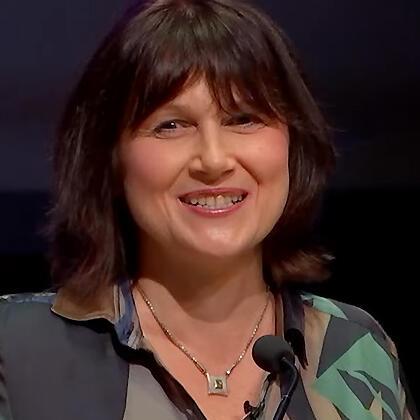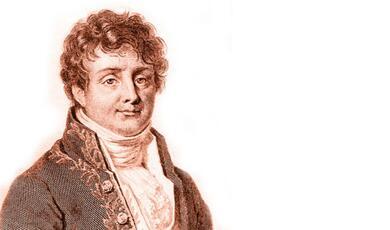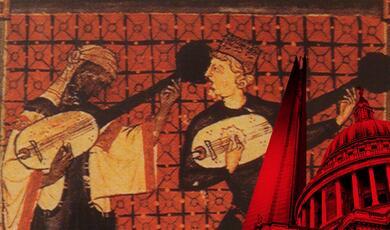Women at the Piano: A History Through Images
Share
- Details
- Text
- Audio
- Downloads
- Extra Reading
This lecture explores the emergence of the "femme au piano" genre in 19th and early 20th-century French painting, with examples by Renoir, Van Gogh, Matisse and countless others. Why did the topic suddenly become so popular? Presented from the perspective of a music historian, this lecture will delve into the roots of the genre: from women and clavichords in the Italian Renaissance, to Dutch domestic scenes and 18th-century ceremonial portraits with harpsichords. We will see how the piano became the centrepiece of middle-class domesticity in the 19th century, and a “woman at the piano” then represented private reflection. The lecture will reveal how these paintings offer us a window onto the history of women’s music-making and their role in society.
Download Text
Women at the Piano: A History Through Images
Prof. Marina Frolova-Walker
10 December 2024
This lecture is a whistlestop tour through four centuries of European painting (1520s–1920s), focused on depictions of women at the piano or other domestic keyboard instruments (harpsichord or clavichord). By the second half of the 19th century, we see the emergence of the “femme au piano” as a distinct genre, which was especially popular in France. These women were generally amateur musicians, and their identity would be unknown to most viewers of the paintings. By contrast, paintings featuring a male pianist did not form a similar genre, simply because the identity of the pianist was crucial: these were portraits of famous musicians, such as Beethoven or Liszt. In this lecture, we will first ask what these paintings tell us about the social history of musical women in various times and places. Secondly, we will look at various iconographical conventions and representations of musical instruments. Thirdly, we will deduce some details of the music that would have been produced by the women of the paintings.
Out of Italy
Paintings from Renaissance Italy often include details that are hard to interpret. In the painting known as The Concert, by the Venice-based Bernardino Licinio, the central figure is a beautiful young woman at the clavichord. Her audience consists of a middle-aged man and an older woman. We might imagine this to be a family scene, but researchers have found that the man is holding a bag of coins (aging has made this difficult for the normal viewer to discern). Knowledge of this detail gives us an entirely different interpretation: the young woman is a courtesan, who uses her musical talents to attract male clients. We will see that scenes of music-making by women often have an erotic charge, with moral dangers lurking.
In contrast, a portrait of a young aristocratic lady at the clavichord by Jan van Hemessen (a Flemish painter who studied in Italy) presents a positive view of a serious and accomplished woman; she may have potential suitors partly in mind, but not clients. The clavichord is painted in such intricate detail that modern instrument makers have been able to reconstruct it. The painter’s daughter, Catharina van Hemessen, produced a similar painting of her sister, which seems to form a pair with her self-portrait at the easel (the first time in history that a female artist portrayed herself that way).
Female artists seem particularly eager to portray themselves at the keyboard, and we shall look at examples by Sofonisba Anguissola and Lavinia Fontana. Another painting of a female keyboardist is attributed to Marietta Robusti (the daughter of Tintoretto), but the attribution has been faulted on musical grounds: the depiction of the clavichord contains several inaccuracies, but Robusti, as a proficient player of the instrument, would not have made such errors in her painting. Here we can witness the birth of another iconographic convention: a standing woman looking at the viewer rather than the instrument, and casually touching a key, which represents her as a musician, but no longer in the act of playing.
St Cecilia at the Keyboard
In this section of the lecture we look at representations of St Cecilia, who came to be regarded as a patron of church music in the late 16th century, and this was extended to musicians in general. She was most often portrayed playing an organ (the keyboard instrument of church music), but there are also several examples with a clavichord. What interests us here is a different way of presenting a musical performer: receiving divine inspiration, looking heavenwards or closing her eyes. These iconographical patterns, as we shall see, were revived in Romantic 19th century paintings in a more secular context, to represent women transported by music, or even the spirits of dead women returning to their pianos.
Genre Scenes from the Dutch 17th century
In the prosperous Dutch Republic we witness perhaps for the first time in history a society in which the pleasures of life were spread across most of the populace. There was a market in art works much as there is today, and a style of painting emerged that was neither ecclesiastical nor aristocratic, featuring realistic domestic scenes from the everyday lives of townspeople. Music-making appears on a substantial proportion (12%) of these paintings, and it is now presented more as a social activity than an individual pursuit. Even when we see a single female musician at a harpsichord, there is usually a bass viol standing next to it, suggesting that a male player is nearby and a duet may occur soon. In Dutch paintings, these keyboard instruments often belong to rich interiors full of beautiful furnishings and decorations, some of which can have a symbolic significance. For example, in the scene of a music lesson by Jan Steen, a key on the wall suggests that the innocent student is the object of the teacher’s desires. A Latin inscription on the virginals in the painting by Gabriel Metsu which means “In thee, O Lord, do I put my trust//Never let me be put to confusion” is a message at odds with the action, where the young woman is about to accept a glass of wine from a male teacher. Vermeer contributed some of the best-known scenes of this type.
18th-century Formal Portraits
The next cluster of paintings consists of grand formal portraits of aristocratic women next to exquisite harpsichords that are decorated with precious materials – these come from various courts of Europe. Some of these women were celebrities of their day, and their elaborate costumes and coiffures match the splendour of their keyboard instruments. Madame Favart (born Marie Duronceray) appears in all her finery in the portrait by François Hubert Drouais. Favart was a famous actress in the genre of opèra comique, and the wife of a playwright. She is portrayed with a two-manual harpsichord, an expensive instrument that was equipped to produce a variety of timbres through combinations of different sets of strings. Madame de Pompadour was a powerful force at the court of Louis XV and a major patron of the arts. In a sketch by François Boucher, her harpsichord is decorated in the contemporary rococo style. The portrait of the opera singer Therese Lanti is particularly extravagant. She turns up in Casanova’s memoirs as someone who masqueraded as a male castrato singer for years before her true identity was discovered. Her elaborate attire is counterbalanced out by the old music manuscript behind her, telling us that she had an intellect capable of interpreting such a document. Finally, we see Marie Antoinette just before she married Louis XVI, in a portrait by Franz Xaver Wagenschön. She continued playing the composers of her homeland during her years in Versailles.
Changing fashions
The piano, invented just before 1700, took a century to displace the harpsichord as the preferred domestic keyboard instrument. At the height of the French Revolution, roughly the same number of harpsichords and pianofortes were expropriated from aristocratic homes. In post-Revolutionary times, the harpsichord has almost completely given way to the piano. We also notice a radical change in styles of dress: the elaborate dresses and towering wigs give way to simple high-waisted white dresses and natural hair. For a short period after the Revolution had passed its peak, there was a transitional style of dress that appears in the beautiful portrait of Mademoiselle Duplant by François-André Vincent. She was a celebrated opera singer in the tragédie lyrique genre; here she is portrayed next to a piano which matches her “Etruscan” chair in style and material. At this time, we see female pianists join female singers in performances on the public stage – their musical education could prepare them for a profession, and not just for catching a wealthier husband. The first internationally celebrated female pianist was Maria Szymanowska, who also published her compositions. In her portrait by Aleksander Коkular, we notice that her hands are not at all dainty. The painter is not trying to emphasise any sensual femininity, but instead presents the hands of a working virtuoso.
As pianos become standardised and production became more industrialised, they were sold in great numbers across Europe and the USA. Middle-class households began to see a piano as an essential item: those who had the space and the money obtained a grand piano; those who did not could still acquire a square piano, and later, an upright piano. It became normal for middle-class girls to develop some degree of skill at the piano – and novels of the period sometimes extract comedy from the efforts of girls with no musical talent dutifully banging away at the piano. The marketing of pianos was clearly directed toward girls rather than boys, since advertisements for pianos feature a picture of a woman at the piano (the same is found even in many sheet-music advertisements). The popular magazines of the time are full of such images, sometimes in earnest, sometime humorous or satirical. In those images we find a new iconographic convention: a vase of flowers is placed either on top of the piano or stands nearby, part of the symbolism for comfortable domesticity. Virginia Woolf, in Orlando, gave us a penetrating and ironic introduction to the development of the middle-class home over the 19th century:
The chill which he felt in his legs the country gentleman soon transferred to his house; furniture was muffled; walls and tables were covered; nothing was left bare. Then a change of diet became essential. The muffin was invented and the crumpet. Coffee supplanted the after-dinner port, and, as coffee led to a drawing room in which to drink it, and a drawing room to glass cases, and glass cases to artificial flowers, and artificial flowers to mantelpieces, and mantelpieces to pianofortes, and pianofortes to drawing-room ballads, and drawing room ballads (skipping a stage or two) to innumerable little dogs, mats and china ornaments, the home—which had become extremely important—was completely altered.
In each home, the piano became the new hearth, the centre of social interactions, entertainment, and courtship. And it was generally brought to life at the hands of a woman.
Interiority
Early in the 19th century, scenes of a woman at the piano were confined mainly to the art of illustrators featured in popular magazines. Easel painters did not turn to the subject until they were inspired by 17th-century Dutch painting, which became familiar through the recent proliferation of educational prints. through prints since the early 19th century. Josef Danhauser provides us with the first 19th century example where the woman is turned away from us – we see her from the back, at a slight angle, but in such a way that her face is hidden. This kind of iconography can be found in Dutch paintings, of which Danhauser was a connoisseur. I see this as a major shift in the portrayal of female amateur performers: it is as if the woman is now allowed her own private space in which she can be left with her own thoughts and reveries. Sometimes an element of sexualisation was introduced even here, but the norm was more sober, with dark or muted colours creating a softer and quieter atmosphere, and the woman neither seeking to attract or evade any male gaze. François Bonvin, another connoisseur of Dutch masters, emerges as a major pioneer of this kind of scene. His Dame au piano from 1848, a sketch in dark colours, was found among the possessions of George Sand’s daughter Aurora. It may be a depiction of Aurora or of George Sand herself, perhaps even playing a piece by Chopin, from who she had already parted and who was severely ill. Frédéric Bazille followed suit with a similar painting in dark colours, which he submitted to exhibit at the Salon (the Académie des Beaux-Arts), although it was rejected. He considered this piece a breakthrough in the context of the French academicism of the day: the portrayal of the everyday life around the artist, instead of grand mythological and historical subjects.
Formal Quests
With Bonvin and Bazille, the “femme au piano” emerges as a genre within French 19th-century painting. Despite the humble subject, this genre became a platform for competition between French painters, with the latest innovations in style and technique. Some of these paintings used friends and relatives rather than paid models, and some were given as gifts rather than sold. Many of these (professional) painters were amateur musicians or music lovers themselves, and social networks in Paris between musicians and painters were tightly interwoven. There is a bizarre story about Degas’ portrait of Madame Manet at the piano, which Degas offered as a gift to Manet. For reasons that remain obscure, Manet was furious and slashed his wife out of the painting. Then, as if to replace the offending canvas, Manet created his own version: a soft, affectionate Suzanne Manet at the Piano. Degas responded with a more ostentatious Mme Camus at the Piano (she was the wife of Manet’s and Degas’s doctor and a brilliant pianist). His particular point of pride was reproducing an elaborate score (by Beethoven, he claimed) with detail that made it almost legible. Paul Cézanne’s Overture to Tannhäuser opens the door to modernism, as a pseudo–Dutch scene explodes in decorative patterns. The monumental dark brown of the upright piano contrasts powerfully with the young woman’s white dress. It is as if the colours and patterns of the whole painting have been suggested by the piano. The mood, however, remains just as enigmatic as any Vermeer. Pierre-Auguste Renoir’s famous Woman at the Piano is a fantasy on a theme of femininity, where even the unwieldy piano shape softens its contours under the influence of the billowy, gauzy blue (note the ever-present vase of flowers, too, which has become an inescapable part of the iconography). Next to Renoir, Gustave Caillebotte deliberately reversed the genre in his Young Man at the Piano, in which the shape of the instrument determines the structure of the painting, its point of view and perspective. He was also one of the first to use the piano as a shiny, reflective object, creating a mirror-image second keyboard and another pair of hands in the open keyboard lid. While Edvard Munch creates a stunning painting that seems to be on the way to abstraction, Pierre Bonnard stylises his canvas so that it approaches the decorative style of popular magazines. Finally, in this section we consider a series of paintings Renoir produced on the theme of Young Girls at the Piano. One of these paintings was bought in 1892 by the French state and thus achieved the status of national treasure. The prettiness, innocence and culturedness of a middle-class domestic pursuit became iconic.
The Music
In this section we will attempt to reconstruct part of the meaning of a painting by listening to the music that its protagonist is playing. The music of Beethoven takes a special place here, because it traditionally stands for the sublime rather than just the beautiful. The dichotomy of the beautiful and the sublime was originally perceived as gendered: women were essentially denied access to the sublime. Playing Beethoven, then, becomes for female pianists a symbolic step towards emancipation (broadly understood). We will consider, for example, A Sonata of Beethoven (1901) by Alfred Edward Emslie, where an uncluttered, even austere domestic space is presented, and filled with light; the piano seems to be a much earlier instrument, and the figure in the background is painted so that we suspect it is the ghost of Beethoven, with the ghost of Beethoven, busy writing in his manuscript book. The majority of our paintings, however, would have been of women playing lighter fare such as operatic excerpts and popular songs. Those, too, can produce moments of particular significance when they become conduits to bittersweet memories.
Modernist Play
In this section. we will briefly consider how the genre of the “femme au piano” had become a cliché by the 1910s, prompting parodic interpretations by several modernist painters, including Albert Gleizes, Kazimir Malevich, and Max Ernst. René Magritte’s Georgette at the piano is a particularly amusing example as it reduces the genre to its bare bones: the piano keyboard, the female figure with a fancy hairdo, and the vase of flowers.
By way of conclusion, I would like to note that among the hundreds of “women at the piano” we find almost none portrayed on the concert stage, despite a large number of prominent female concert pianists from mid-19th century onwards. This would of course require a completely different iconographic typology and therefore we shouldn’t rush to blame the painters for remaining seemingly oblivious to this development. The lack of exploration of this alternative underlines the fact that the types of painting we have traced through four centuries was closely tied to the particular social practice of amateur music-making at home. With all the ambiguities and exceptions, it was a pursuit open to women of the upper class, and later the middle class, a pursuit that was compatible with women’s relatively restricted roles in society but which at the same time opened for them a private space and an opportunity for self-reflection and self-realisation. This topic began to lose its significance in the early 20th century, when it became much more common for woman to enter public life (at the higher end of society), or to enter the industrial workplaces (at the lower end). Soon, even the role of the domestic amateur pianist was reallocated to the gramophone.
© Professor Marina Frolova-Walker 2024/5
References and Further Reading
Bergquist Stephen A., “Women at the Keyboard: The World of Domestic Music-Making”. International Journal for Music Iconography 48 (2023), 107-125.
Eyerman, Charlotte Nalle. The Composition of Femininity: The Significance of the "Woman at the Piano” Motif in Nineteenth-Century French Culture from Daumier to Renoir (PhD diss). University of Berkeley, 1997.
Eyerman, Charlotte N. "Playing the market: Renoir's Young girls at the piano series of 1892." In Music and Modern Art, pp. 37-59. Routledge, 2014.
Leppert, Richard. The Sight of Sound: Music, Representation, and the History of the Body. University of California Press, 1993.
Meling, Lise Karin. "‘The Lady at the Piano’: From Innocent Pastime to Intimate Discourse." Music & Practice 5 (2019).
Moskvina, A. Painting the Invisible: Images of St Cecilia in Early Modern Italy. HARTS & Minds: The Journal of Humanities and Arts, 1 (2014).
Sternbach, Jessica. “Virginal Spaces: Feminine Music and Space in Dutch Seventeenth-Century Painting”, https://rar.rutgers.edu/virginal-spaces-feminine-music-and-space-in-dutch-seventeenth-century-painting-by-jessica-sternbach/
Vorachek, Laura. " ‘The Instrument of the Century’: The Piano as an Icon of Female Sexuality in the Nineteenth Century”. George Eliot-George Henry Lewes Studies 38/39 (2000): 26-43.
© Professor Marina Frolova-Walker 2024/5
References and Further Reading
Bergquist Stephen A., “Women at the Keyboard: The World of Domestic Music-Making”. International Journal for Music Iconography 48 (2023), 107-125.
Eyerman, Charlotte Nalle. The Composition of Femininity: The Significance of the "Woman at the Piano” Motif in Nineteenth-Century French Culture from Daumier to Renoir (PhD diss). University of Berkeley, 1997.
Eyerman, Charlotte N. "Playing the market: Renoir's Young girls at the piano series of 1892." In Music and Modern Art, pp. 37-59. Routledge, 2014.
Leppert, Richard. The Sight of Sound: Music, Representation, and the History of the Body. University of California Press, 1993.
Meling, Lise Karin. "‘The Lady at the Piano’: From Innocent Pastime to Intimate Discourse." Music & Practice 5 (2019).
Moskvina, A. Painting the Invisible: Images of St Cecilia in Early Modern Italy. HARTS & Minds: The Journal of Humanities and Arts, 1 (2014).
Sternbach, Jessica. “Virginal Spaces: Feminine Music and Space in Dutch Seventeenth-Century Painting”, https://rar.rutgers.edu/virginal-spaces-feminine-music-and-space-in-dutch-seventeenth-century-painting-by-jessica-sternbach/
Vorachek, Laura. " ‘The Instrument of the Century’: The Piano as an Icon of Female Sexuality in the Nineteenth Century”. George Eliot-George Henry Lewes Studies 38/39 (2000): 26-43.
© Professor Marina Frolova-Walker 2024/5
This event was on Tue, 10 Dec 2024
Support Gresham
Gresham College has offered an outstanding education to the public free of charge for over 400 years. Today, Gresham College plays an important role in fostering a love of learning and a greater understanding of ourselves and the world around us. Your donation will help to widen our reach and to broaden our audience, allowing more people to benefit from a high-quality education from some of the brightest minds.


 Login
Login







